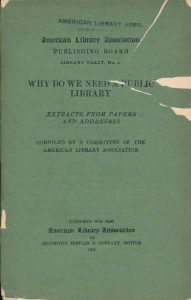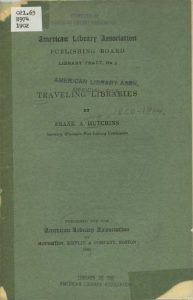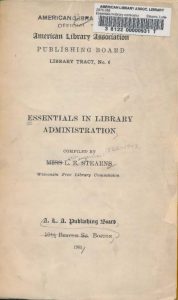From 1900 until 1910, the American Library Association produced a series of publications about general issues in library administration known as Library Tracts. Each installment is rich in the experienced perspectives of library leaders of its time. Read on to learn more about Library Tracts!
Published by Houghton, Mifflin, and Company of Boston, and printed by The Riverside Press of Cambridge, Massachusetts, the first two Library Tract numbers describe purpose and the establishment of public libraries. Why Do We Need a Public Library, is a compilation of extracts from papers and addresses. The authors include the Connecticut Public Library, J. N. Larned, W. E. Foster, James Russell Lowell, W. I. Fletcher, Melvil Dewey, Sir Walter Besant, Andrew Carnegie, and Joseph LeRoy Harrison.
While Worcester County Law Library’s George E. Wire‘s How to Start a Public Library is a twelve-page essay that gives general advice for starting a public library. Mr. Wire advises learning about state statutes concerning libraries, to organize a group of supporters, to advertise the idea in the community, to anticipate anti-library arguments, establish the organization, organize the trustees, hire a librarian, choose a library model, and plan to grow the library overtime rather than build too much too soon.
The next two Library Tract numbers describe library spaces. In Wisconsin Free Library Commission Secretary Frank A. Hutchins‘ Traveling Libraries, the author identifies major causes of traveling library failures (uninteresting books and limited funding for collection development) and he advises how traveling libraries can be administrated effectively.
While in A.L.A. Endowment Fund Trustee Charles C. Soule‘s Library Rooms and Buildings, the author describes optimal designs for libraries of various sizes and spaces, including one room libraries, multiple-room libraries, adapting a current building into a library, building a new small library, and building a new large library.
The next two Library Tract numbers explain library administration issues. In New York State Library School alumni Charles Ammi Cutter‘s Notes from the Art Section of a Library, the author explains collection development in the administration of an art section. Adapted from a talk to a published essay, Mr. Cutter explains that art objects share purposes with other public library objects, as they serve to: 1) please or recreate; 2) instruct or enlighten; 3) improve and elevate both morally and spiritually. The author explains each of these ideas as they guide the development of an art section’s collections to meet the needs of library users, using examples from art history, architecture, portraits, water colors, engravings, etchings, wood engravings, original drawings, book illustrations, photographs, and more.
While in Wisconsin Free Library Commission member (who you read about earlier in an earlier blog post) Miss Lutie E. Stearns‘ Essentials in Library Administration, the author revises the previous publication Handbook of Library Organization of the Library Commissions of Minnesota, Iowa, and Wisconsin, as an extension of the first two Library Tract numbers. This is the largest issue with over one-hundred pages, an alphabetical subject index, and sample forms for library administration use too.
The Library Tract series continued for a total of ten issues, published in multiple editions over the course of a decade, and other publication series were produced alongside this series too. The early twentieth century saw a great expansion of A.L.A. publications guiding and supporting libraries and librarians across the country and the world.
Copies Available at Your ALA Archives
Physical copies of Library Tracts publications are available for viewing at the ALA Archives. Please view the Record Series 13/10/1 database record entry, for more information.
Got Something to Donate to the Story So Far?
Many people have been involved in the long history of A.L.A. publications and library leadership. Do you have any information about early Library Tract participants, collaborators, publications, or beneficiaries? Please contact us through social media. We and our readers would like to read about it.





